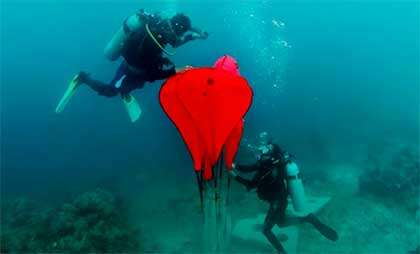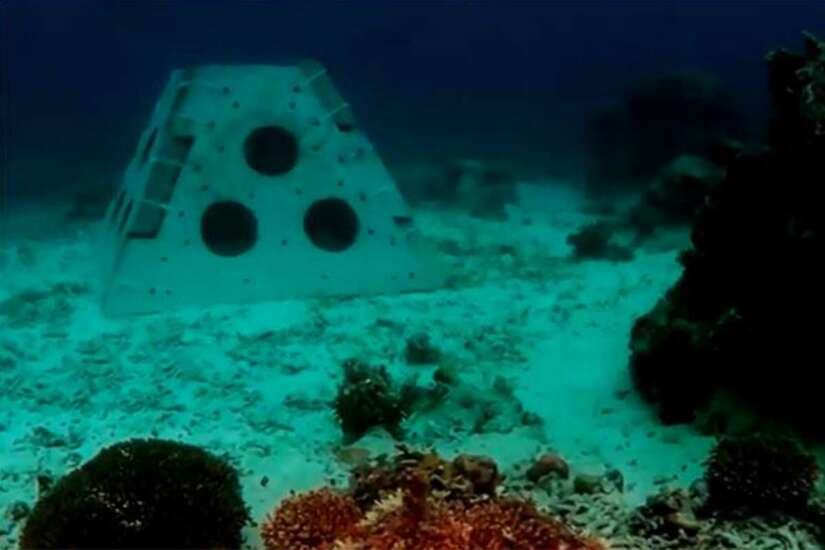The Department of Social Welfare and Development (DSWD) prioritizes the importance of implementing programs that protect the environment from the impacts of climate change. One of these is the Kapit-Bisig Laban sa Kahirapan Comprehensive and Integrated Delivery of Social Services (KALAHI-CIDSS), a community-driven development program that empowers poor municipalities to identify, plan, implement, and monitor sub-projects that will address the problems of their localities.
In Oslob, Cebu, residents of the coastal barangay of Gawi received sets of artificial reefs from KALAHI-CIDSS to revive their marine ecosystem after being affected by several typhoons.
During Typhoon Pablo in 2013, majority of the coral reefs were totally destroyed in Brgy. Gawi, and when Typhoon Odette came in December 2021, the recovering corals were again destroyed with approximately 80% of the marine area being devastated. For the residents, the remedy was to rehabilitate and install typhoon-resilient concrete pyramid-shaped artificial reef structures that can be used as “planting” materials for coral fragments.
“We have been struck by a series of typhoons, and the only way to rehabilitate our marine area is to install artificial reefs. Kay murag nahawan gyud ang ilawom sa dagat ug nawash-out ang mga corals nga maoy puy-anan sa mga isda” (it seems that the bottom of that ocean’s floor has been cleared and the corals that serve as habitat have been washed out), village chieftain Marco F. Suson stated.
 Community volunteers and local officials identified the restoration of their marine ecosystem and revival of their fishing livelihood through the installation of artificial reefs as their priority project and presented it to the DSWD for KALAHI-CIDSS grant. They received artificial reefs composed of 25 sets of mid-profile pyramids, 47 sets of low-profile pyramids, and 220 round coral tables amounting to P881,800.00. The artificial reefs will be installed in an 82,500-square meter seabed at Gawi Marine Sanctuary.
Community volunteers and local officials identified the restoration of their marine ecosystem and revival of their fishing livelihood through the installation of artificial reefs as their priority project and presented it to the DSWD for KALAHI-CIDSS grant. They received artificial reefs composed of 25 sets of mid-profile pyramids, 47 sets of low-profile pyramids, and 220 round coral tables amounting to P881,800.00. The artificial reefs will be installed in an 82,500-square meter seabed at Gawi Marine Sanctuary.
These artificial reefs are made of reinforced concrete slabs which, when assembled into a pyramid-shaped artificial reefs, can withstand strong waves, even those generated by strong typhoons. The Gawi community proposed the designs of these structures to mimic natural reefs that can provide habitat and encourage marine organisms to settle upon while increasing their productivity, which will eventually help maintain the fishing livelihood of the locality.
To set up the artificial reefs, the community tapped a local environmental advocacy group called “Blue Thumb” which encourages divers to “plant” broken coral fragments as their way to help in restoring, protecting, and saving a dying reef back to life or rehabilitating devastated corals within the Gawi Marine Sanctuary. Among the members of the advocacy group that were mobilized include diver- volunteers from various affiliations and agencies, free divers, and environmentalists.
Through the intervention of KALAHI-CIDSS, the participation of community members heightened by encouraging more people to take part in noteworthy community service during the consultation and installation of the artificial reefs.
On November 26 and 27, 2022, the Gawi community members finally launched the installation of artificial reefs.
“We know that we cannot work on this project alone. That’s why we employed the spirit of volunteerism that KALAHI-CIDSS taught us by mobilizing Blue Thumb to install the artificial reefs,” Suson explained citing that the advocacy group helped them despite the bad weather conditions and strong waves during the 2-day activity.
Meanwhile, Oslob Mayor Ronald L. Guarin said he was inspired by the concern of the DSWD for his community. He is hopeful that the project will bring back the rich marine life in his town.
“Nanginahanglan kita sa mga produkto sa atoang kadagatan apan kinahanglan usab nga panalipdan nato ang atoang kalikupan. Mao nga na-inspired ko sa gibuhat sa KALAHI-CIDSS ug sa komunidad sa Gawi kay dako kaayo kini og tabang sa pag-uswag sa atong lungsod” (We need resources from the ocean, but we have to protect our environment. That’s why I am inspired by the KALAHI-CIDSS and the community of Gawi for doing this because it is really a big help in the development of our town), Mayor Guarin said.
To ensure the sustainability of the artificial reefs in the marine sanctuary, the Gawi Fisherfolks Association, will receive P50,000 per year from the LGU for the operations and management of the sanctuary, including sustainability evaluation, regular clean-up drives, coral planting, and monitoring coral growth.
“Plano sa atong lungsod nga molungtad ug molahutay kini nga proyekto aron mas daghan ang matabangan sama sa pagpalambo sa atong turismo ug paghatag og oportunidad sa atong mananagat tungod sa ka-abunda sa kadagatan” (Our town plans to make this project sustainable so that it will boost our tourism and provide opportunities for our local fisher folks out from the bountiful resources found in our oceans), the Mayor added.
Through the artificial reefs, the DSWD is hopeful that the project will provide local communities a viable habitat for marine life that will bolster the abundance of rich marine natural resources.

